team negative1 : Reel Reviews - Film Print Analysis
Last Update : 2020.05.25|
Explanation : 'Reel Reviews' document the information and features found in 35mm movie prints. team negative1 focuses on the 'Star Wars' films. Purpose : To better understand film history through the documentation and investigation of the codes and other aspects of a film print contained outside the projection image. To better understand the work which went into the creation of the 'Star Wars' films. To document the variations between Reels to better understand the development of these films. To learn what changes occurred to specific shots and when those changes occurred as home video versions may not have fully documented the evolution of the 'Star Wars' films. To get to know film better. Current Output : Reel Review 0001 thru 0006 videos document the codes and features found in a 1983 35mm LPP Dolby Stereo Spanish Language print of the movie 'Star Wars'. The film print has been spliced to replace the opening crawl with an earlier print and the Han Solo/Greedo sequence has been replaced with an earlier English language audio piece of film. Reel Reviews 0001 thru 0006 provide an initial baseline for the codes and features of the entire movie which will then be compared to future Reel Reviews or pieces of film you might have access to, to document and understand where and why the film changed. Process : The :F:D: visually inspected the reel using a hand crank set up. The observed data was inputted into a spreadsheet, which permitted the data to be overlaid onto a re-filmed version of the print. An example frame can be seen to the right. (additional explanation of the coding will be explained in detail below) We hope that interested people will help us verify and interpret the data, which we'll then include in future updates. Thank You : A list of the entities or people involved in the original Reel creation and later preservation generations.
Note : This document is produced by an amateur lucky enough to be haphazardly educated by others who took the time to make me better informed. I’m learning as I go along and do not have any training in the field. I've enjoyed a film and was curious how it was put together and why it was put together in the manner I saw it evolve over time. Corrections welcomed. Upon receiving the prints, I dived in writing down whatever features I saw; without taking the time better understand the process and what I should expect to observe. So this a little scatterbrained, apologies. Inspirational Quote : "That's what really scared me, the day George told me that in twenty years or so they won't be able to make movies like these. Rather than advancing, people are dying off and not telling their secrets. Well I was depressed for the rest of the day." - Mark Hamill at "MidAmeriCon (1976) Worldcon - Star Wars Q&A" Watch Quote at https://youtu.be/gmhjvkj8_aw?t=805 (Clip includes run up to quote: ~2 min.) |
Reel Review Example Frame
Reel Review - General Guide
Reel Review Examination Setup
Reel Review - Working Spreadsheet Data - Version v0.1 - Page 01 of 17
|
|
Reel Review Naming Convention : Below is the naming convention used in the Reel Review process.At the right is a list of Reel Reviews which have been completed. Reel Review : 0000 (Identification Number)Each Reel Reviewed in this process will get the next available number. According to boxofficemojo.com the Star Wars film was at one point in 1,750 theaters. Many prints existed, each with multiple reels; but only a percentage of those have survived to today.Print Identification Number : Film TitleIn the leader of each 35mm reel are handwritten codes which identify the print source. The P.I.N. is a unique number associated with the conformed negative.Reel Review 0001 leader codes: First Set 
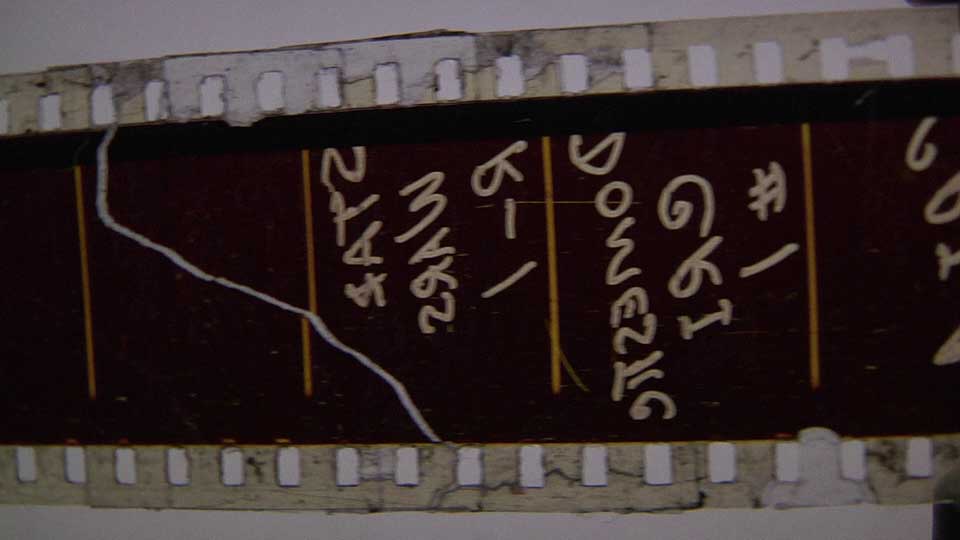


Note : These exact codes can be found on 16mm prints of 'Star Wars'. Star Wars 16mm English (PuggoGrande) Leader More on the Leaders of the 'Star Wars' films can be found at the following OriginalTrilogy.com thread Credits & Leaders Thread Additional information on Leaders https://ieeexplore.ieee.org/stamp/stamp.jsp?arnumber=7264029 Reel Review 0003 & 0004 Leader codes 



Year Produced : Film Type : Sound Type : LanguageThe 'Year Produced' value is identified from the Edge Code symbol found in the Beyond Sprocket Edge Area. Refer to FilmPreservation.org's Edge Code Chart but more on the Reel Review Edge Codes can be found in a different section of this website. The 'Film Type' value identifies the type of film the print was developed onto. Reel Reviews 0001 thru 0006 were done on LPP (Lowfade Positive Print) stock (5384/7384 Eastman Color Low-Fade Print), that code can be seen in some of the picts above at the bottom of the image. The 'Sound Type' will identify method in which the audio was printed into the reel. The 'Star Wars' films have previously been identified to have Dolby Stereo and Mono mixes. The 'Language' will identify the language of the audio.Spreadsheet DocumentWhen documenting each Reel would periodically save as a new spreadsheet file name, typically everyday time was spent reviewing. So with the start and end of each reel review have a general sense of how long it took.MiscellaneousSome other codes might be used in this process. For example it might be worth noting when multiple reels all originated from a single release. The code 'RA' (Reel All) will be used. Another thing worth noting might be if a print is a combination of different source. For example Reel 0001 is a 'F' (Frankenprint), the crawl and Greedo scenes were replaced with an earlier version. |
Reel Review : 0000 (Identification Number) Print Identification Number : Film Title : Year Produced : Film Type : Sound Type : Language Start : Date : Spreadhseet File Name End : End Review Date ; Spreadsheet File Name Reel Review : 0001 180615 : Star Wars : 1983 : LPP : R1 : Dolby Stereo : Spanish Start : 2013.08.28: 1.v2e001a.xlsx End : 2013.09.02 : 1.v2e001e.xlsx Reel Review : 0002 180615 : Star Wars : 1983 : LPP : R2 : Dolby Stereo : Spanish Start : 2013.09.08 : 1.v2e001f.xlsx End : 2013.09.15 : 1.v2e001h.xlsx Reel Review : 0003 180615 : Star Wars : 1983 : LPP : R3 : Dolby Stereo : Spanish Start : 2013.09.15 : 1.v2e001h.xlsx End : 2013.09.29 : 1.v2e001n.xlsx Reel Review : 0004 180615 : Star Wars : 1983 : LPP : R4 : Dolby Stereo : Spanish Start : 2013.09.29 : 1.v2e001o.xlsx End : 2013.11.24 : 1.v2e001p.xlsx Reel Review : 0005 180615 : Star Wars : 1983 : LPP : R5 : Dolby Stereo : Spanish Start : 2013.11.30 : 1.v2e001q.xlsx End : 2013.12.01 : 1.v2e001t.xlsx Reel Review : 0006 180615 : Star Wars : 1983 : LPP : R6 : Dolby Stereo : Spanish Start : 2013.12.15 : 1.v2e001u.xlsx End : 2013.12.22 : 1.v2e001z.xlsx Reel Review : 0007 Start : 2015.03.29 : 2.v2e001.xlsx End : 2015.05.24 : 2.v2e001h.xlsx ______ : Star Wars : 1978 : R6 : Scope : English Reel Review : 0008 Start : 2016.03.14 : DEL_188075-v1e001.xlsx End : 2016.09.12 : DEL_188075-v1e009.xlsx 188075 : Empire Strikes Back : 1980 : R1 : English Reel Review : 0009 Start : 2016.09.17 : DEL_188075-v1e010.xlsx End : 2016.10.06 : DEL_188075-v1e018.xlsx 188075 : Empire Strikes Back : 1980 : R2 : English Reel Review : 0010 Start : 2016.11.01 : 2.v2e001i.xlsx End : 2016.11.24 : 2.v2e001q.xlsx ______ : Star Wars : 1978 : R5 : Scope : English Reel Review : 0011 Start : 2017.01.14 : 3.v3e001a.xlsx End : 2017.01.17 : 3.v3e001b.xlsx ______ : Star Wars : 1978 : R6 : Scope : English Reel Review : 0012 Start : End : 2017.01.29 : ______ : Empire Strikes Back : Reel Review : 0013 Start : 2018.02.24 : End : 2018.02.24 No Valuable Codes ______ : Empire Strikes Back : : Fuji : English |
1. Projected Visible Frame / Visible Frame1A. Projected Visible Frame : The area which shows up when projected on the screen in a movie theater.1B. Visible Frame : The complete extents of the Original Camera Negative which captured an image when shot on set or as the plate for a special effects shot. |
Reel Review - Projected Visible Frame Examples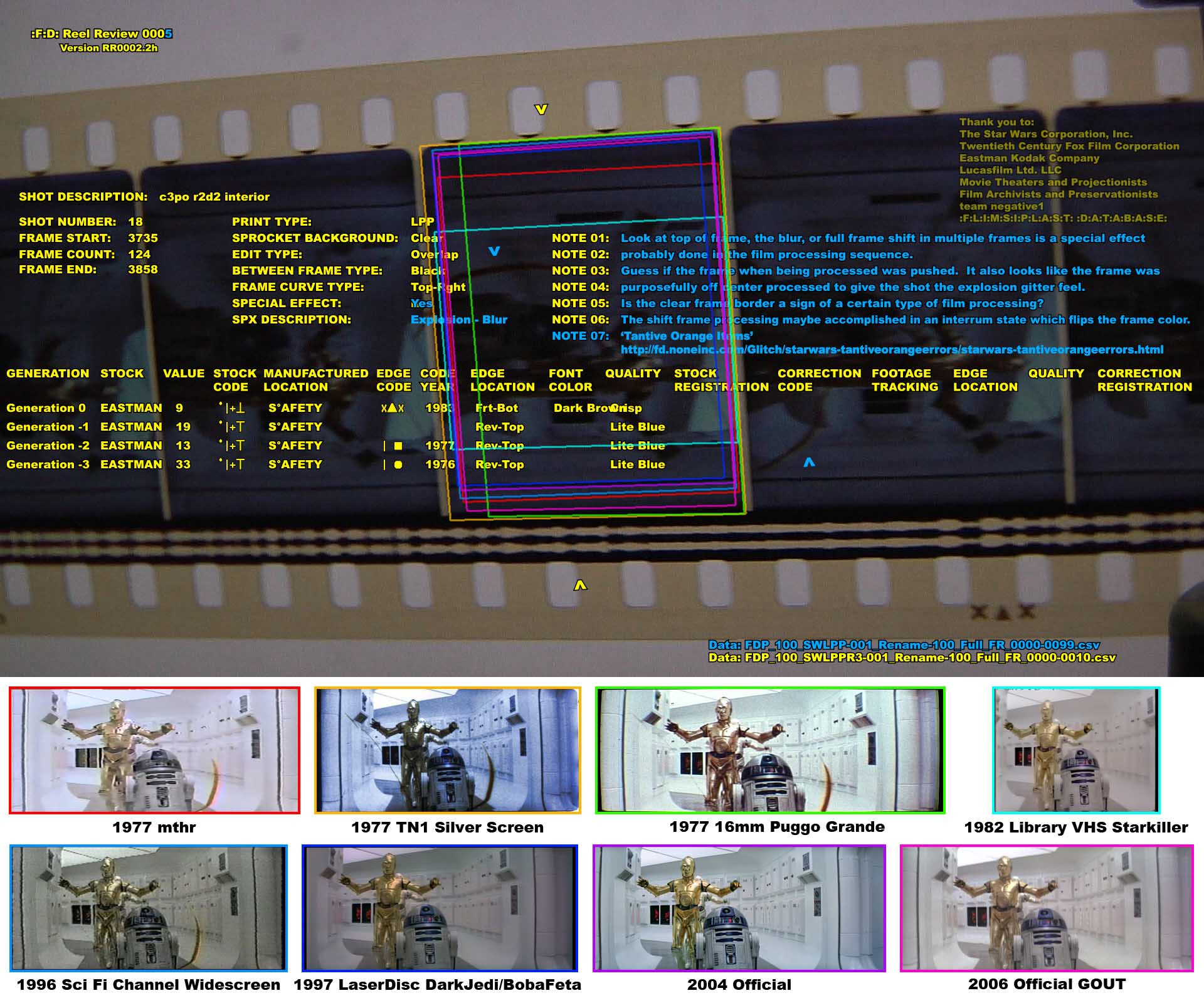
|
2. Frame Border TypesThe elements which surround the Visible Frame will be identified as Frame Border Type elements.
2A.1. Frame Border - Consistent Three Sides : Black : A thin black edge separates the visible frame from the sprocket row. [Refer to Shot RR-0001 0021] 2A.2. Frame Border - Consistent Three Sides : Clear : The frame border between frames matches the clear between sprockets. [Refer to Shot RR-0001 0018] 2B. Frame Border - Unique Top/Bottom of Frame : Description and variations forthcoming 2B.1. Frame Border - Unique Top/Bottom of Frame : Registration Black : Shot 0179 is a special effects shot which has a black registration shift at the bottom of each frame. The special effect was the inclusion of the small Sand Crawler in the distance as C-3po waves to it. 2C. Frame Border - Unique Right of Frame (Top) : Description and variations forthcoming 2D. Frame Border - Unique Left of Frame (Bottom) : Description and variations forthcoming 2E.1. Frame Curve Type - Two Right of Frame (Top) : Only the Right of Frame (Top) corners of the visible frame have curved edges. The Left of Frame (Bottom) set are overwritten by the soundtrack. [Refer to Shot 15] 2E.2. Frame Curve Type - Four (All Corners) : All four corners of the visible frame have curved edges. [Refer to RR-0001 Shot 0020] 2F. Other Atypicals : Description and variations forthcoming 2F.1. Frame Border - Wipes (Wide-Black) : All the wipes have a wide frame border. Possibly because each wipe required multiple passes exposing the same frame for a different element, the borders might allow for less bleeding of the film exposing light. Note: This category is not fully documented in this initial release. The Right of Frame (Top) is a place which has a greater variation and might be a section which gets broken out as we evaluate these types in future work. For example Shot 0015 has Three Sides Black but then there is a white line with a thin black border. This is a byproduct of the special effects work. Identifying which shots have this common feature could help us understand which ILM team did the work and what type of machine it was accomplished on. |
Reel Review - Frame Border Types - Right / Top ExamplesType 2A.1. RR-0001 Shot 0021
Type 2A.2. RR-0001 Shot 0021
Type 2A.2.  RR-0001 Shot 0018
Type 2C.1. RR-0001 Shot 0018
Type 2C.1.  RR-0001 Shot 0010
Type 2C.2. RR-0001 Shot 0010
Type 2C.2.  RR-0001 Shot 0266
Type 2F.1. RR-0001 Shot 0266
Type 2F.1.  RR-0001 Shot 0266 RR-0001 Shot 0266
Reel Review - Frame Border Types - Top / Bottom Examples
|
3. Soundtrack3A. Soundtrack - Mono : Description Forthcoming3B. Soundtrack - Dolby Stereo : Description Forthcoming 3C. Soundtrack - Other : Description Forthcoming 3C.1. Soundtrack - Audio Marker Triangle : At several points in the soundtrack after a section of silence, a triangle can be seen over the soundtrack. [Refer to RR-0001 Shot 0001] If anyone ever heard one channel fade out earlier than the other, here's the reason.
|
Reel Review - Soundtrack - Dolby Stereo3B. RR-0001 Shot 0018 RR-0001 Shot 0018
Reel Review - Soundtrack - Audio Marker Triangle3C.1.a. RR-0001 Shot 0001
3C.1.b. RR-0001 Shot 0001
3C.1.b.  RR-0001 Shot 0005
3C.1.c. RR-0001 Shot 0005
3C.1.c.  RR-0001 Shot 0007
3C.1.d. RR-0001 Shot 0007
3C.1.d.  RR-0002 Shot 0467 RR-0002 Shot 0467
|
4. Sprocket Rows (Perfs or Perforations)4A. Clean unaffected Sprocket Rows : The sprocket holes have no affected areas. The perforations are of the KS (Kodak Standard) shape.4B. Sprocket Row shows Negative Sprocket Edge : The sprocket hole of the final print (KS Shape) differs from the negative (BH shape). In some shots when the film is developed the sprocket hole difference leaves a black mark at the Right of Frame (Top) set of sprocket holes. [Refer to RR-0001 Shot 0033] For more information and a full explanation of 'KS' and 'BH' perforations types visit: |
Reel Review - Sprocket Rows4A. RR-0001 Shot 0021
4B. RR-0001 Shot 0021
4B.  RR-0001 Shot 0018 RR-0001 Shot 0018
|
5. Edge (Beyond) Sprocket Areas
| ||||||||||||||||||||||||||||||||||
|
5A.1. Print Type - LPP : The LPP code is printed every 16 frames and for RR-0001 thru RR-0006 is seen only once as the earlier generations were produced prior to this film stocks creation date. It stands for Lowfade Positive Print and was a film stock created by the Eastman Film Company. This stock was used from 1983 to circa 1993. Also known as 5384/7384. [Refer to RR-0001 Shot 0016]
5A.2. Print Type - ? : Work on identifying/understanding the earlier generations of print stock used on the 'Star Wars' films. Per http://web.archive.org/web/20070907134704/http://www.kodak.com/US/en/motion/support/h1/typesNamesNo.shtml should probably divide this category into A. Camera Film, B. Laboratory Film & C. Print Film. Also learn if special effects work gets divided between one or multiple of the previous three categories. |
Reel Review - General Guide5A.1.a. RR-0001 Shot 0019
5A.1.a. RR-0001 Shot 0019
5A.1.a.  RR-0001 Shot 0010 RR-0001 Shot 0010
| |||||||||||||||||||||||||||||||||
|
5B.1. Print Stock - KODAK : Film stock produced by Kodak. [Note : Categorize the font variations.] 5B.2. Print Stock - EASTMAN : Film stock produced by Eastman.
5C. Stock Value : Values between 1 and 36 were observed in Reel Reviews 0001 thru 0006. [Refer to 5B. examples] 5D. Stock Code (Slit Markings) : When film is produced it is made in large sheets which are cut down to the different specifications of the end films type: 35mm, 16mm, 8mm, etc. Each strip in that sheet is identified with a code, the Slit Marking. Below is a chart made by Thomas Robinson who worked at the Oregon Historical Society as a volunteer negative cataloger. The codes found in Reel Review 0001 thru 0006 use similar symbols but the combinations differ. [Included with 5B. examples] |
Examples : Print Stock, Stock Value and Stock Code (Slit Markings)5B.1.a. RR-0001 Shot 0001
5B.2.a. RR-0001 Shot 0001
5B.2.a.  RR-0001 Shot 0001
5B.2.b. RR-0001 Shot 0001
5B.2.b.  RR-0001 Shot 0001
5B.2.c. RR-0001 Shot 0001
5B.2.c.  RR-0001 Shot 0001
5B.2.d. RR-0001 Shot 0001
5B.2.d.  RR-0001 Shot 0010
5B.2.e. RR-0001 Shot 0010
5B.2.e.  RR-0001 Shot 0323
5B.2.f.1. RR-0001 Shot 0323
5B.2.f.1.  RR-0002 Shot 0409
5B.2.f.2. RR-0002 Shot 0409
5B.2.f.2.  RR-0002 Shot 0575
5B.2.g. RR-0002 Shot 0575
5B.2.g.  RR-0002 Shot 0467 RR-0002 Shot 0467
| |||||||||||||||||||||||||||||||||
|
5E. Manufacturing Location : Location where Eastman/Kodak film stock was manufactured. In Reel Reviews 0001 thru 0006 codes for the Rochester (U.S.A.) and England locations were observed. Also referred to as "Plant of Origin".
Example of multiple stacked codes :
|
Reel Review - General Guide RR-0001 Shot 0001 RR-0001 Shot 0001
 RR-0001 Shot 0001 RR-0001 Shot 0001
 RR-0001 Shot 0001 RR-0001 Shot 0001
 RR-0001 Shot 0009 RR-0001 Shot 0009
 RR-0001 Shot 0321 RR-0001 Shot 0321
 RR-0001 Shot 0323 RR-0001 Shot 0323
 RR-0001 Shot 0324 RR-0001 Shot 0324
 RR-0001 Shot 0409 RR-0001 Shot 0409
 RR-0001 Shot 0409 RR-0001 Shot 0409
| |||||||||||||||||||||||||||||||||
|
5F. Edge (Date) Code : The year the film stock was manufactured is identified through a series of symbols made up of: Circles, Squares, Triangles, 'X's and Pluses. 
|
Reel Review - General Guide1975 RR-0001 Shot 0324
1977 RR-0001 Shot 0324
1977  RR-0001 Shot 0001
1980 RR-0001 Shot 0001
1980 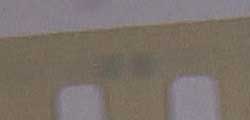 RR-0001 Shot 0127
1983 RR-0001 Shot 0127
1983  RR-0001 Shot 0018
1983 RR-0001 Shot 0018
1983  RR-0001 Shot 0010 RR-0001 Shot 0010
| |||||||||||||||||||||||||||||||||
|
5G. Edge Numbers / Frame Identification Codes / KeyKode : Numerical Values which are used to identify any frame in a strip of film. I'm not certain of the appropriate term for these codes, in Reel Reviews 0001 thru 0006 they are identified as 'Correction Code' and 'Footage Tracking'. The codes are a two set grouping which has a two to four digit prefix followed by a numerical value. Making the assumption these are the codes which can be used to track down every specific frame. These would be the codes used by the editor and negative cutter to piece together the Original Camera Negative. Believe these codes are printed onto the film at the Manufacturing plant. With the introduction of computers, KeyKode was developed which used 'Key Number' and 'Footage Number' to speed up the processes of finding clips. In the Reel Review process we'll document the different code sets for each film manufacturer. The font changes are probably specific to a certain year of manufacturering by a specific company. Also we will see if we can find archive documents from Lucasfilm or ILM which show any of these specific codes in relation to a specific shot or scene. Special Effects processing 'Log Sheets' have been known to show similar codes.
|
Reel Review - General Guide##X ##### RR-0001 Shot 0010
##X ##### RR-0001 Shot 0010
##X #####  RR-0001 Shot 0010
##X ##### RR-0001 Shot 0010
##X #####  RR-0006 Shot 2214
D#X ##### RR-0006 Shot 2214
D#X #####  RR-0006 Shot 2214
D##X ##### RR-0006 Shot 2214
D##X #####  RR-0001 Shot 0010
D##X ##### RR-0001 Shot 0010
D##X #####  RR-0002 Shot 0409 RR-0002 Shot 0409
 H##X ####### : RR-0002 Shot 0368 H##X ####### : RR-0002 Shot 0368
 ## S##### : RR-0001 Shot 0323 ## S##### : RR-0001 Shot 0323
| |||||||||||||||||||||||||||||||||
6. Edit Types6A. Edit Type - Clean : An Edit which does not disturb the visible frames fo the shots before and after the edit. 6B. Edit Type - Clean-Clear : Description Forthcoming 6C. Edit Type - Clean-Cut : Description Forthcoming 6D. Edit Type - Clean-Dot : Description Forthcoming 6E. Edit Type - Clean-Wide : Description Forthcoming 6F. Edit Type - Clean-Wide-Black : Description Forthcoming 6G. Edit Type - Cut : An edit which cuts into the bottom of the visible frame. 6H. Edit Type - Cut-Clean-Wide-Black : Description Forthcoming 6I. Edit Type - Cut-Dot : Description Forthcoming 6J. Edit Type - Cut-Dot-Clear : Description Forthcoming 6K. Edit Type - Cut-Dot-Wide : Description Forthcoming 6L. Edit Type - Cut-Dot-Wide-Black : Description Forthcoming 6M. Edit Type - Cut-Dot-Yellow : Description Forthcoming 6N. Edit Type - Cut-Dot-Yellow : Description Forthcoming 6O. Edit Type - Cut-Wide : Description Forthcoming 6P. Edit Type - Cut-Wide-Dot : Description Forthcoming 6Q. Edit Type - Cut-Yellow : Description Forthcoming 6R. Edit Type - Dots : Description Forthcoming 6S. Edit Type - Overlap : Description Forthcoming 6T. Edit Type - Wide : Description Forthcoming 6U. Edit Type - Wide-Black : Description Forthcoming 6V. Edit Type - Wide-Black-Dot : Description Forthcoming 6W. Edit Type - Wide-Dot : Description Forthcoming 6X. Edit Type - Wide-Orange : Description Forthcoming Note : The 'Edit Type' category needs a complete overhaul. Did not have a clear sense of the variations when starting so gave word combinations to describe what I was seeing, but over time those terms got shifted around so there are not multiple categories which are probably the same. Extracting pics of each type and providing different photographs will assist in this task. The 'Dot' aspect of the edit is hard to read in the Reel Review 0001 thru 0006 scan. The Main Edit types will probably come down to:
Note : |
Reel Review - General Guide



|
7. Other Markers, Elements, Codes and Features7A. Reel Cue Marker : At the end of each reel are two sets of four frames with cue marks in the corner to alert the projectionist when to start the motor of the other projector and when to start that next reel to play. The first set is known as the 'motor cue' the second the 'changeover cue'. The example at the right is from the motor cue of Reel 1.
7B. 16 Frame Marker : Below the soundtrack every sixteen (16) frames is a marker between the sprockets. 7C. Specialty Marker : In the Left/Bottom beyond sprocket area this marker can be found, an edge print about one frame in length. My guess is they might be a marker used during the negative cutting or editing to assist in the work. For some sections of the film, the markers were found a certain number of frames before the last frame of that shot. Each shot in a sequence would be the same, then a different sequence would have the marker at a different number of frame before the end of the shot. I think I remember a set where they were a certain number of frames after the start of the shot. 7D. "3M" : Found in the leader but only once. Do not know it's significance. 7E. "POS" : This might stand for positive as in interpositive, one of the stages of film duplication. |
7A. Reel Cue MarkerRR-0001 Shot 0323
16 Frame MarkerRR-0001 Shot 0009
h5>Specialty Marker RR-0002 Shot 0516
"3M" ElementRR-0001 Leader
"POS" ElementRR-0001 Leader
|
8. Handwritten ElementsIn Reel Review 0001 Shot 0002 in the beyond sprocket edge is handwritten 'STAR WARS R-1 CRI #1'. (Maybe it's 'CRI #2' with the top part of the two cut by the sprockets.) |
Handwritten - 'STAR WARS R-1 CRI #1'
|
Film Control : The People and Equipment which helped make Star Wars.American Cinematographer : July 1977 Quote : The department called "Control" has the responsibility of vaulting and routing each piece of film generated for this project. Control catalogues each piece of negative, and print, and their relationship to the 2 to 12 other pieces with which they will be combined in composite. Control has the responsibility of keeping infinitely accurate records and making film elements and information available on a moment's notice, a tremendous task considering the some 3,838 elements required for the 365 projected individual shots. On the right are pictures from "Film Control" during the production of 'Star Wars'. The People behind Film ControlImages from J. W. Rinzler's "The Making of Star Wars" book.The first picture shows Mary M. Lind "Film Control Coordinator" who oversaw the tracking system to identify and locate any piece of the film for the editors and special effect coordinators. In the background of the shot are the film archives which can be better seen in the second photo. Each box would contain a 10" reel of film. In the second photograph, in the hand of Connie McCrum is probably one of the 'Log Sheets' which identified the specific shot, and what elements of film are needed to complete the work for that shot. The third photograph is an example Log Sheet from a scene in the Empire Strikes Back. But you can see the "Edge No" category which has values similar to what was documented in the Reel Review. The 'Code No' seem to be the translation of the frame count when the shots are resequenced into the final shot for the film from their origin during filming.https://universostarwars.mforos.com/667501/8912377-anecdotas-the-making-of-sobre-star-wars/?pag=2 Quote : They performed 273,369 optical effects. As soon as the tremendous success of the film was known, several props used in the film disappeared. "When a film becomes successful, any piece of props becomes very valuable and disappears," stresses Mary Lind. "At this point, we all begin to lock each department," he adds. As responsible for "Film Control" Lind had the last mission to find a safe place with the right technology to keep the now incredibly valuable negatives of the film safe and secure. The place chosen by her was the Hollywood Film Company, on Seward Street, with black and white elements stored in chests 203 and 204 and the negatives of the film in 336, when her last mission was completed Mary fled on vacation to Hawaii, went to a taxi that took her straight to the airport, wearing only a bathing suit and sandals. |
Mary Lind "Film Control Coordinator"
Film Control Office - Connie McCrum, Cindy Isman and Mary Lind
Example Log Sheet - [From 'The Empire Strikes Back']
Equipment in Film Control - 'unidentified' ILM Shot Tracker
|
EditorsJohn Jympson Richard Chew Paul Hirsch Marcia Lucas George LucasThis section might be interesting to find stories from the editors about their contribution. For example, remember reading about how the sequencing of the dialog between Ben and Luke in Ben's Hutt was resequenced from the screen play to add urgency to the scene. The scene might have had a few cameras and the Edge Codes might corroborate where the edits moved footage around. One story corroborated is from Paul Hirsch's book A Long Time Ago in a Cutting Room Far, Far Away he describes (page 113-115) how an error in the reading of the Edge Code led to a missing frame in the final film. Refer to the last example in the Features-001 about the Death Star Explosion. |
Richard Crew (editor) at a Steenbeck editing table
|
Equipment322,704 feet of tape were obtained of which 226,717 were printed. Meanwhile, the Van Der Veer Photo Effects company dealt with the animation of the laser beams of the blasters and the effects of the lightsabers. https://theasc.com/magazine/starwars/articles/starwars/mm/index.htm |
Reel Review - General Guide
Reel Review Example Frame
Reel Review Example Frame
|
Step Forthcoming & Corrections
Data Insertion Scripting Correction : The script used to input the .CSV spreadsheet date into Adobe After Effects is fractions of a second off. So when you watch each 100 Shot Reel Review file, the Shot value becomes slightly off and gets worse as time increases. Because of how the script works, the first frame of each new shot should be devoid of the information overlay. My guess is it could be the difference between 24 FPS and 23.976 FPS. In After Effects must need to conform the overlay to the video's speed. Will post the working files to see if someone can suggest a fix.Data Correction : Work with the larger public to identify and correct concepts and values in the current data set. To aid in that process :F:D: will provide a Color Correction Pass.
Color Correction Pass : In the Features-001 page the third example down is an examples of a color correction pass we will complete over the entire reel review and distribute for assistance from anyone interested in spotting codes we missed in the first pass. We believe that color correction can enhance a bunch of the harder to read codes to be readable. We'll probably ask for assistance on a methodology to apply to the entire reels and then release that corrected version. The color correction pass shown in the Features-001 page are primarily modifying 'Curves' and 'Brightness & Contrast' values in photoshop. :F:D: will release the modified video on the site and am thinking that maybe a weekly time is set up to review each scene and find a group conscientious on the codes and make a revise Reel Review spreadsheet, enhancing with what is learned along the way.
New Scan : Get a better quality scan of future reels and redo of RR0001 thru RR0006. team negative1's stockpile of abandoned equipment is constantly evolving and that may lead to better things.
Public Examines their Reels or Parts of Reels : The general public might have access to frames, shots or additional reels. Reviewing those codes for changes will help identify where these films changed over time.
Star Wars Taxonomy (aka Star Wars Family Tree) : The Reel Reviews can help us start to differentiate the film permutations with another set of data.
Resources
http://web.archive.org/web/20070809163228/http://historicphotoarchive.com/f1/ekcode.html https://paulivester.com/films/filmstock/guide.htm https://en.wikipedia.org/wiki/List_of_motion_picture_film_stocks https://www.filmpreservation.org/userfiles/image/PDFs/fpg.pdf https://ieeexplore.ieee.org/stamp/stamp.jsp?arnumber=7264029 https://erikpiil.files.wordpress.com/2014/06/piil_characteristics_archiving.pdf https://www.itsmarc.com/crs/mergedprojects/archmov/archmov/appendix_f_eastman_kodak_edge_date_codes.htm https://cinematography.com/index.php?/topic/3345-color-reversal-intermediate-cri-transfer/ https://www.kodak.com/us/en/motion/about/chronology_of_film/1960-1979/default.htm https://www.kodak.com/uploadedfiles/motion/Guide_to_Identifying_Year_of_Manufacture.pdf https://www.youtube.com/watch?v=6bjsKHKpniI [21:00 watch negative cutter splice film], [Lordy Clips 27:20 device to trigger color correction might be visible, after the 60s a notch outside of the sprockets might be visible.] https://www.youtube.com/watch?v=4-d0W6hMxwo (#2) "How film is made" Kodak 1958 factory documentary (part 2 of 2) https://www.youtube.com/watch?v=DNhSFQmnMcE Kodak Film Factory Tour https://en.wikipedia.org/wiki/Edit_decision_list https://en.wikipedia.org/wiki/Negative_cutting https://en.wikipedia.org/wiki/Original_camera_negative https://shotonwhat.com/star-wars-episode-iv-a-new-hope-1977 https://en.wikipedia.org/wiki/Release_print https://en.wikipedia.org/wiki/Internegative https://en.wikipedia.org/wiki/Answer_print https://en.wikipedia.org/wiki/Interpositive https://cinematography.com/index.php?/topic/72345-35mm-film-reel-optical-negative-vs-printmaster-vs-interpositive-vs-internegative/ https://filmcolors.org/timeline-entry/1310/Outside Sources to Confirm
A. In Paul Hirsch's book A Long Time Ago in a Cutting Room Far, Far Away he describes how "five optical effects houses" (page 113) completed shots for 'Star Wars' where ILM was understaffed. One of these companies did the laser blasts. Create an article which pulls out many of the laser blast shots to see if they have common traits. Many laser blast shots have a red shifted 'Right/Top' Frame Edge.
B. In 'Star Wars Insider Issue July 2017' page 48 David Tanaka talks about tracking down the original elements which were composited into all the special effects shots from the original negatives. He might have stories to tell about edge code and what he found when trying to piece Star Wars back together for the Special Editions.
C. Compare to other existing known images of 'Star Wars' prints.
Example 1 : via https://filmcolors.org/galleries/star-wars-episode-iv-a-new-hope/ Star Wars: Episode IV – A New Hope (USA 1977, George Lucas). Credit: Library of Congress. Photographs of the faded Eastman Color Print Film by Barbara Flueckiger.
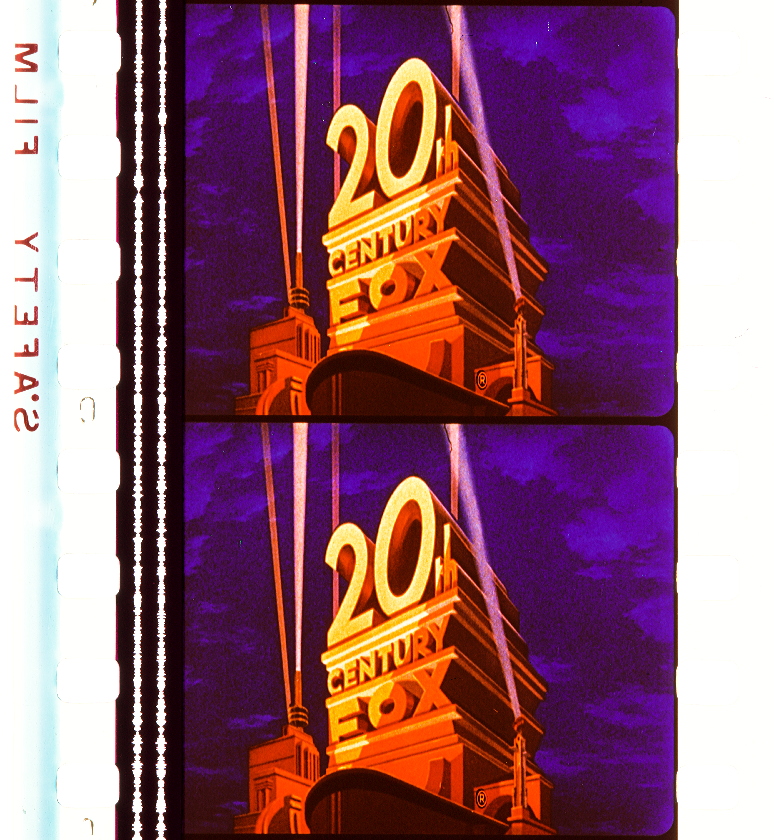
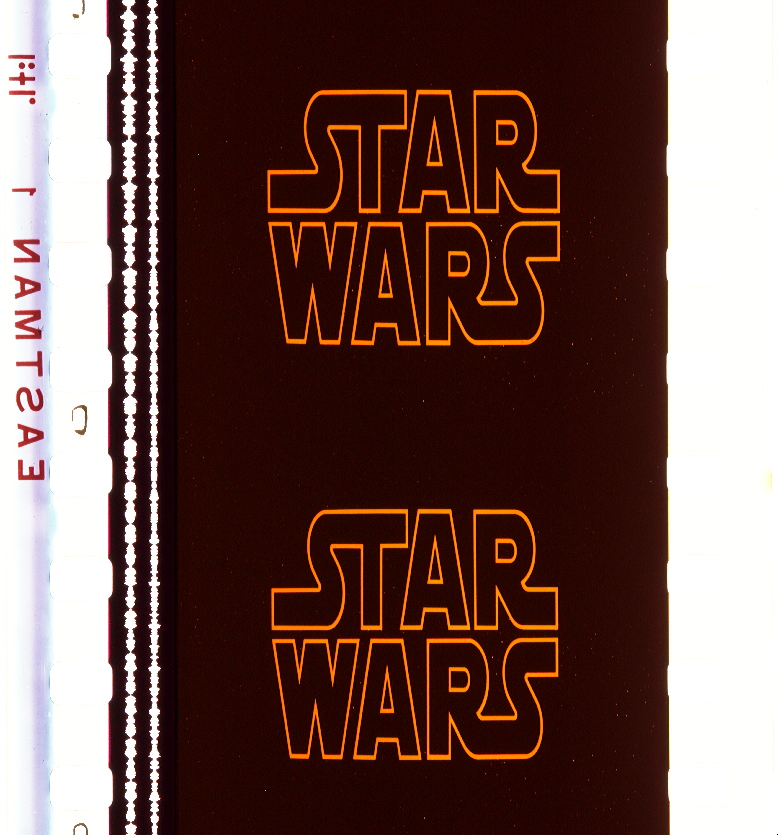
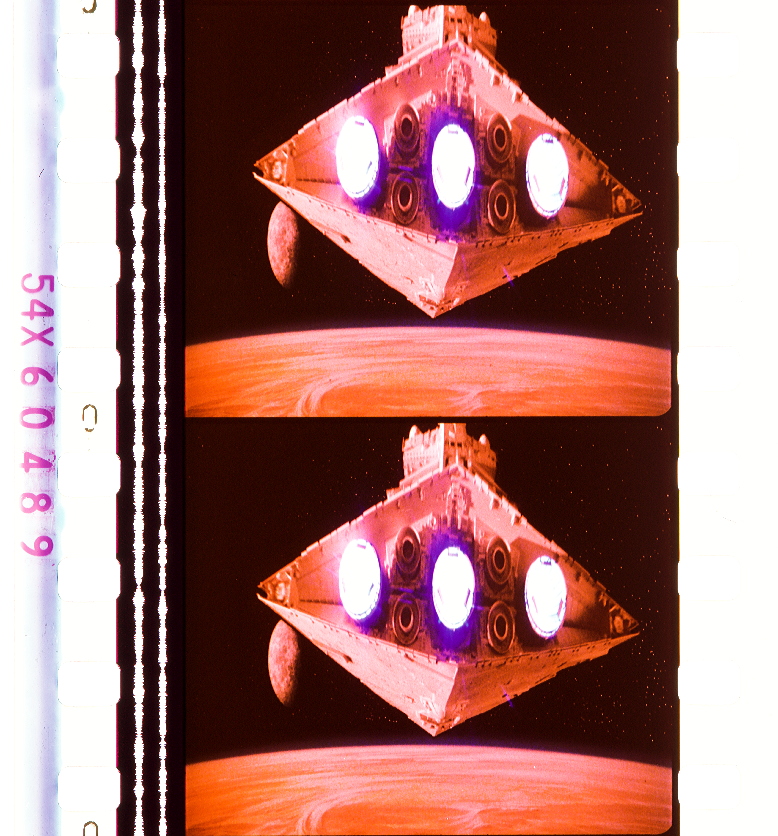
Reel Review - Working ProcessForthcomingVisual Inspection Notes Spreadsheet Issues Film Scanning Spreadsheet Data Overlay |
Reel Review - General Guide |
 Typical Black
Typical Black
 Typical Clear
Typical Clear
 SandcrawlerSpecial Effect
SandcrawlerSpecial Effect
 Four Curves(All Corner)
Four Curves(All Corner)
 WipeWide Frame
WipeWide Frame
 To help determine which sets of edge codes occurred before others looking at stacked/overlapping codes can help. In this case the white codes are over printed with the purple and the black/brown seem to be printed over both. So this probably represents three of the generations which went into this shot. The direct and orientation are clues to the process these codes were printed in. The white and purple being mirrorred might signify they are specific to the interneg/pos step. The white has the • between the 'F' and 'E' showing an origin of England and probably means they are the original negative shot on set, while the purple and black/brown codes origin from Rochester, U.S.A. and were done in post production and/or final duplication.
To help determine which sets of edge codes occurred before others looking at stacked/overlapping codes can help. In this case the white codes are over printed with the purple and the black/brown seem to be printed over both. So this probably represents three of the generations which went into this shot. The direct and orientation are clues to the process these codes were printed in. The white and purple being mirrorred might signify they are specific to the interneg/pos step. The white has the • between the 'F' and 'E' showing an origin of England and probably means they are the original negative shot on set, while the purple and black/brown codes origin from Rochester, U.S.A. and were done in post production and/or final duplication.
